Federation University: Business, Society and Planet Reflective Journal
VerifiedAdded on 2022/09/26
|6
|1340
|18
Journal and Reflective Writing
AI Summary
This reflective journal delves into the concept of sustainable business, analyzing its impact on society and the planet. The author discusses key concepts learned from coursework, including the importance of sustainability, the triple bottom line (profit, people, planet), and the six forms of capital (natural, human, social, manufactured, financial, and intellectual). The journal highlights the role of corporate social responsibility and the United Nations' Sustainable Development Goals. It examines the six-phase model of sustainable business, from rejection to a sustaining corporation, and concludes that both large and small enterprises have a responsibility to adopt sustainable practices. The journal references several academic sources and provides examples of sustainable businesses in Australia. The author emphasizes that transforming organizations can transform the world. The author also highlights the ecological footprint and its importance.
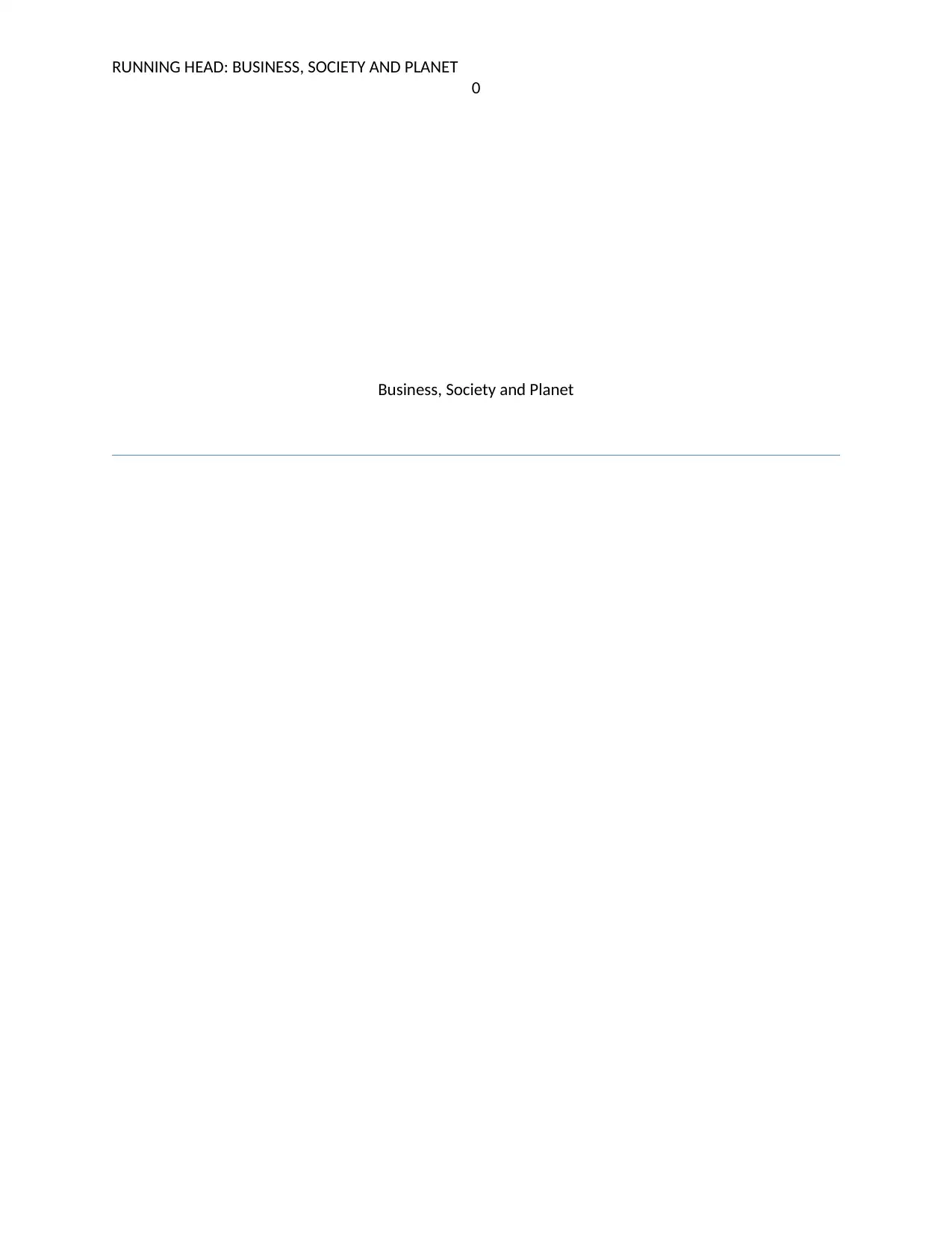
RUNNING HEAD: BUSINESS, SOCIETY AND PLANET
0
Business, Society and Planet
0
Business, Society and Planet
Paraphrase This Document
Need a fresh take? Get an instant paraphrase of this document with our AI Paraphraser
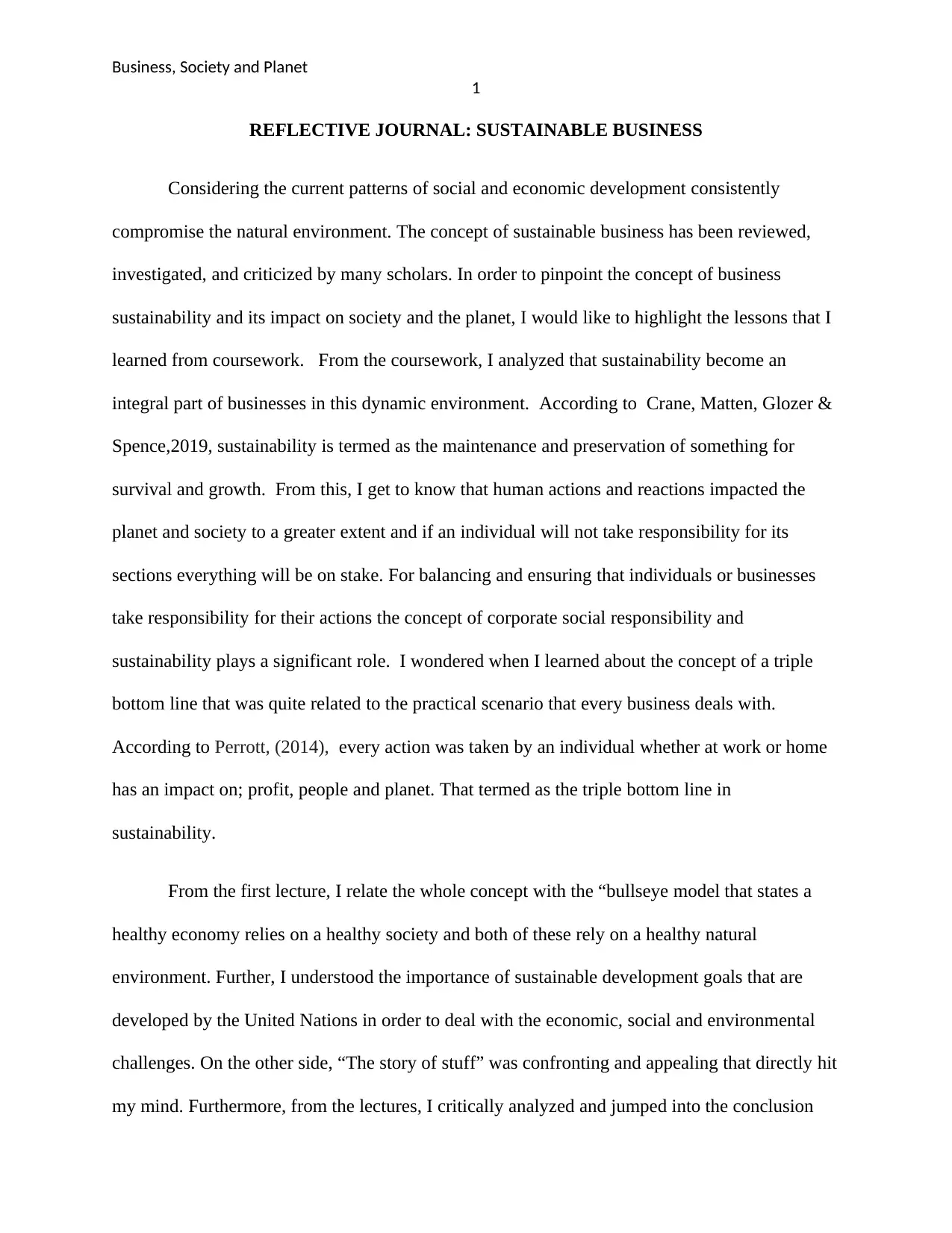
Business, Society and Planet
1
REFLECTIVE JOURNAL: SUSTAINABLE BUSINESS
Considering the current patterns of social and economic development consistently
compromise the natural environment. The concept of sustainable business has been reviewed,
investigated, and criticized by many scholars. In order to pinpoint the concept of business
sustainability and its impact on society and the planet, I would like to highlight the lessons that I
learned from coursework. From the coursework, I analyzed that sustainability become an
integral part of businesses in this dynamic environment. According to Crane, Matten, Glozer &
Spence,2019, sustainability is termed as the maintenance and preservation of something for
survival and growth. From this, I get to know that human actions and reactions impacted the
planet and society to a greater extent and if an individual will not take responsibility for its
sections everything will be on stake. For balancing and ensuring that individuals or businesses
take responsibility for their actions the concept of corporate social responsibility and
sustainability plays a significant role. I wondered when I learned about the concept of a triple
bottom line that was quite related to the practical scenario that every business deals with.
According to Perrott, (2014), every action was taken by an individual whether at work or home
has an impact on; profit, people and planet. That termed as the triple bottom line in
sustainability.
From the first lecture, I relate the whole concept with the “bullseye model that states a
healthy economy relies on a healthy society and both of these rely on a healthy natural
environment. Further, I understood the importance of sustainable development goals that are
developed by the United Nations in order to deal with the economic, social and environmental
challenges. On the other side, “The story of stuff” was confronting and appealing that directly hit
my mind. Furthermore, from the lectures, I critically analyzed and jumped into the conclusion
1
REFLECTIVE JOURNAL: SUSTAINABLE BUSINESS
Considering the current patterns of social and economic development consistently
compromise the natural environment. The concept of sustainable business has been reviewed,
investigated, and criticized by many scholars. In order to pinpoint the concept of business
sustainability and its impact on society and the planet, I would like to highlight the lessons that I
learned from coursework. From the coursework, I analyzed that sustainability become an
integral part of businesses in this dynamic environment. According to Crane, Matten, Glozer &
Spence,2019, sustainability is termed as the maintenance and preservation of something for
survival and growth. From this, I get to know that human actions and reactions impacted the
planet and society to a greater extent and if an individual will not take responsibility for its
sections everything will be on stake. For balancing and ensuring that individuals or businesses
take responsibility for their actions the concept of corporate social responsibility and
sustainability plays a significant role. I wondered when I learned about the concept of a triple
bottom line that was quite related to the practical scenario that every business deals with.
According to Perrott, (2014), every action was taken by an individual whether at work or home
has an impact on; profit, people and planet. That termed as the triple bottom line in
sustainability.
From the first lecture, I relate the whole concept with the “bullseye model that states a
healthy economy relies on a healthy society and both of these rely on a healthy natural
environment. Further, I understood the importance of sustainable development goals that are
developed by the United Nations in order to deal with the economic, social and environmental
challenges. On the other side, “The story of stuff” was confronting and appealing that directly hit
my mind. Furthermore, from the lectures, I critically analyzed and jumped into the conclusion
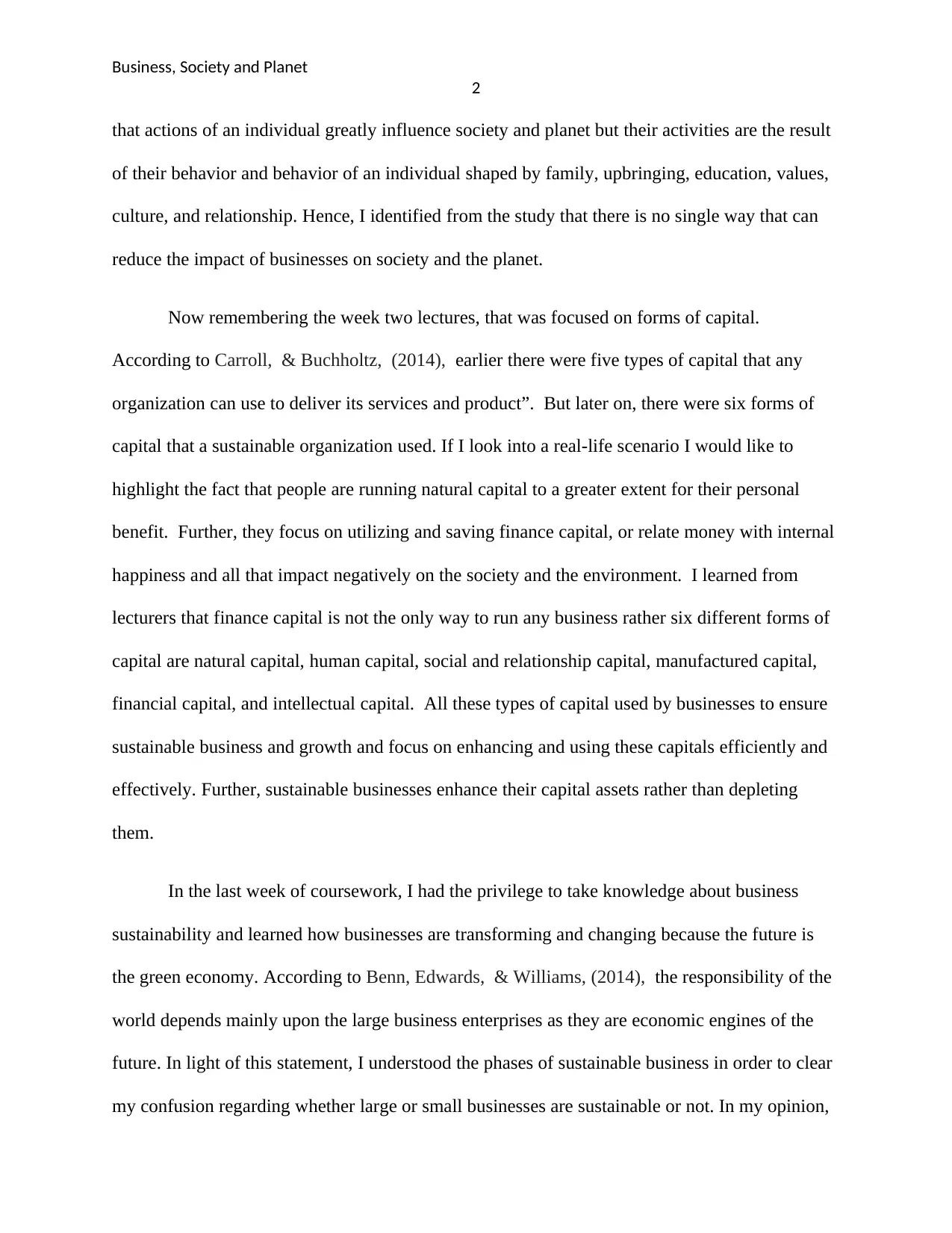
Business, Society and Planet
2
that actions of an individual greatly influence society and planet but their activities are the result
of their behavior and behavior of an individual shaped by family, upbringing, education, values,
culture, and relationship. Hence, I identified from the study that there is no single way that can
reduce the impact of businesses on society and the planet.
Now remembering the week two lectures, that was focused on forms of capital.
According to Carroll, & Buchholtz, (2014), earlier there were five types of capital that any
organization can use to deliver its services and product”. But later on, there were six forms of
capital that a sustainable organization used. If I look into a real-life scenario I would like to
highlight the fact that people are running natural capital to a greater extent for their personal
benefit. Further, they focus on utilizing and saving finance capital, or relate money with internal
happiness and all that impact negatively on the society and the environment. I learned from
lecturers that finance capital is not the only way to run any business rather six different forms of
capital are natural capital, human capital, social and relationship capital, manufactured capital,
financial capital, and intellectual capital. All these types of capital used by businesses to ensure
sustainable business and growth and focus on enhancing and using these capitals efficiently and
effectively. Further, sustainable businesses enhance their capital assets rather than depleting
them.
In the last week of coursework, I had the privilege to take knowledge about business
sustainability and learned how businesses are transforming and changing because the future is
the green economy. According to Benn, Edwards, & Williams, (2014), the responsibility of the
world depends mainly upon the large business enterprises as they are economic engines of the
future. In light of this statement, I understood the phases of sustainable business in order to clear
my confusion regarding whether large or small businesses are sustainable or not. In my opinion,
2
that actions of an individual greatly influence society and planet but their activities are the result
of their behavior and behavior of an individual shaped by family, upbringing, education, values,
culture, and relationship. Hence, I identified from the study that there is no single way that can
reduce the impact of businesses on society and the planet.
Now remembering the week two lectures, that was focused on forms of capital.
According to Carroll, & Buchholtz, (2014), earlier there were five types of capital that any
organization can use to deliver its services and product”. But later on, there were six forms of
capital that a sustainable organization used. If I look into a real-life scenario I would like to
highlight the fact that people are running natural capital to a greater extent for their personal
benefit. Further, they focus on utilizing and saving finance capital, or relate money with internal
happiness and all that impact negatively on the society and the environment. I learned from
lecturers that finance capital is not the only way to run any business rather six different forms of
capital are natural capital, human capital, social and relationship capital, manufactured capital,
financial capital, and intellectual capital. All these types of capital used by businesses to ensure
sustainable business and growth and focus on enhancing and using these capitals efficiently and
effectively. Further, sustainable businesses enhance their capital assets rather than depleting
them.
In the last week of coursework, I had the privilege to take knowledge about business
sustainability and learned how businesses are transforming and changing because the future is
the green economy. According to Benn, Edwards, & Williams, (2014), the responsibility of the
world depends mainly upon the large business enterprises as they are economic engines of the
future. In light of this statement, I understood the phases of sustainable business in order to clear
my confusion regarding whether large or small businesses are sustainable or not. In my opinion,
⊘ This is a preview!⊘
Do you want full access?
Subscribe today to unlock all pages.

Trusted by 1+ million students worldwide
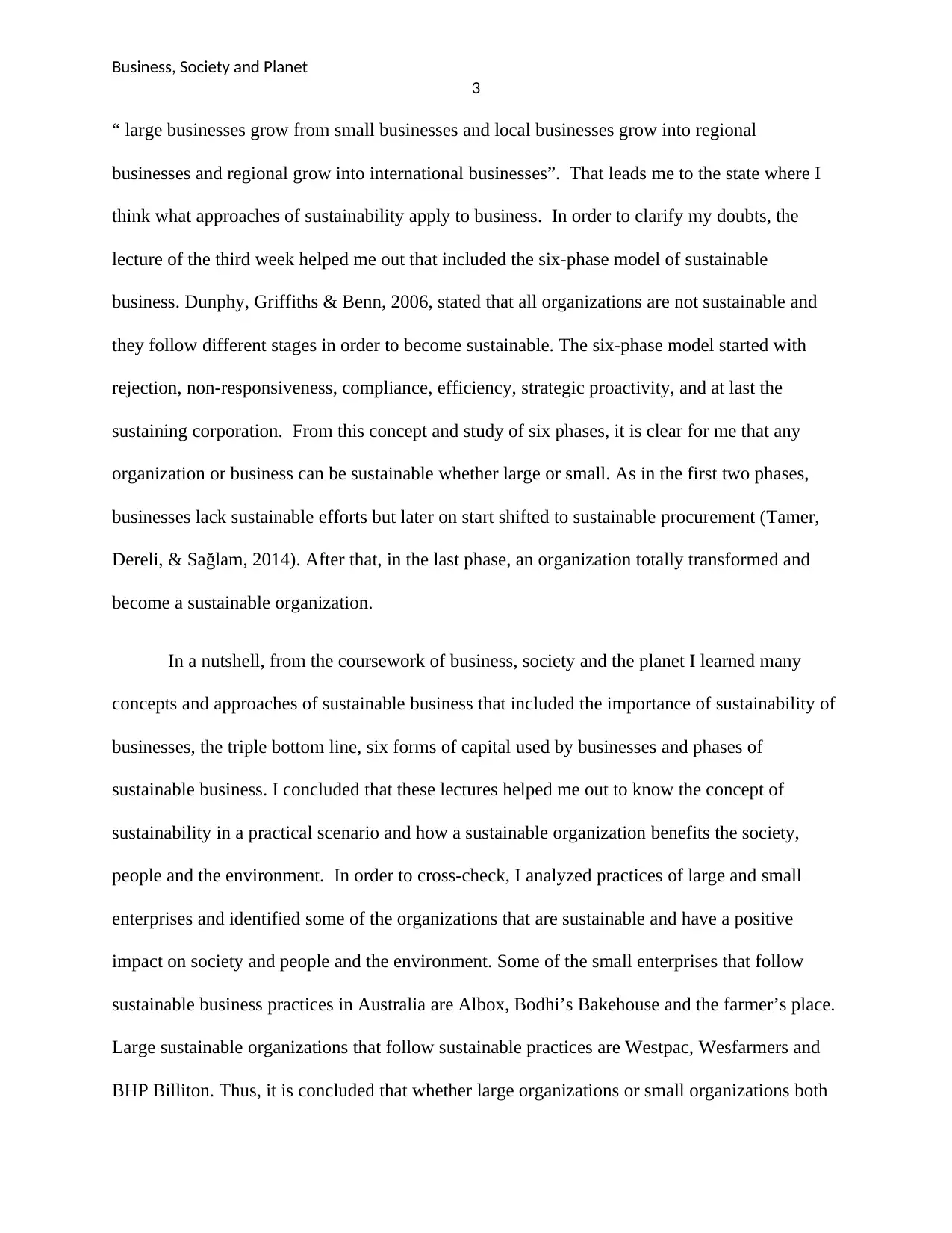
Business, Society and Planet
3
“ large businesses grow from small businesses and local businesses grow into regional
businesses and regional grow into international businesses”. That leads me to the state where I
think what approaches of sustainability apply to business. In order to clarify my doubts, the
lecture of the third week helped me out that included the six-phase model of sustainable
business. Dunphy, Griffiths & Benn, 2006, stated that all organizations are not sustainable and
they follow different stages in order to become sustainable. The six-phase model started with
rejection, non-responsiveness, compliance, efficiency, strategic proactivity, and at last the
sustaining corporation. From this concept and study of six phases, it is clear for me that any
organization or business can be sustainable whether large or small. As in the first two phases,
businesses lack sustainable efforts but later on start shifted to sustainable procurement (Tamer,
Dereli, & Sağlam, 2014). After that, in the last phase, an organization totally transformed and
become a sustainable organization.
In a nutshell, from the coursework of business, society and the planet I learned many
concepts and approaches of sustainable business that included the importance of sustainability of
businesses, the triple bottom line, six forms of capital used by businesses and phases of
sustainable business. I concluded that these lectures helped me out to know the concept of
sustainability in a practical scenario and how a sustainable organization benefits the society,
people and the environment. In order to cross-check, I analyzed practices of large and small
enterprises and identified some of the organizations that are sustainable and have a positive
impact on society and people and the environment. Some of the small enterprises that follow
sustainable business practices in Australia are Albox, Bodhi’s Bakehouse and the farmer’s place.
Large sustainable organizations that follow sustainable practices are Westpac, Wesfarmers and
BHP Billiton. Thus, it is concluded that whether large organizations or small organizations both
3
“ large businesses grow from small businesses and local businesses grow into regional
businesses and regional grow into international businesses”. That leads me to the state where I
think what approaches of sustainability apply to business. In order to clarify my doubts, the
lecture of the third week helped me out that included the six-phase model of sustainable
business. Dunphy, Griffiths & Benn, 2006, stated that all organizations are not sustainable and
they follow different stages in order to become sustainable. The six-phase model started with
rejection, non-responsiveness, compliance, efficiency, strategic proactivity, and at last the
sustaining corporation. From this concept and study of six phases, it is clear for me that any
organization or business can be sustainable whether large or small. As in the first two phases,
businesses lack sustainable efforts but later on start shifted to sustainable procurement (Tamer,
Dereli, & Sağlam, 2014). After that, in the last phase, an organization totally transformed and
become a sustainable organization.
In a nutshell, from the coursework of business, society and the planet I learned many
concepts and approaches of sustainable business that included the importance of sustainability of
businesses, the triple bottom line, six forms of capital used by businesses and phases of
sustainable business. I concluded that these lectures helped me out to know the concept of
sustainability in a practical scenario and how a sustainable organization benefits the society,
people and the environment. In order to cross-check, I analyzed practices of large and small
enterprises and identified some of the organizations that are sustainable and have a positive
impact on society and people and the environment. Some of the small enterprises that follow
sustainable business practices in Australia are Albox, Bodhi’s Bakehouse and the farmer’s place.
Large sustainable organizations that follow sustainable practices are Westpac, Wesfarmers and
BHP Billiton. Thus, it is concluded that whether large organizations or small organizations both
Paraphrase This Document
Need a fresh take? Get an instant paraphrase of this document with our AI Paraphraser
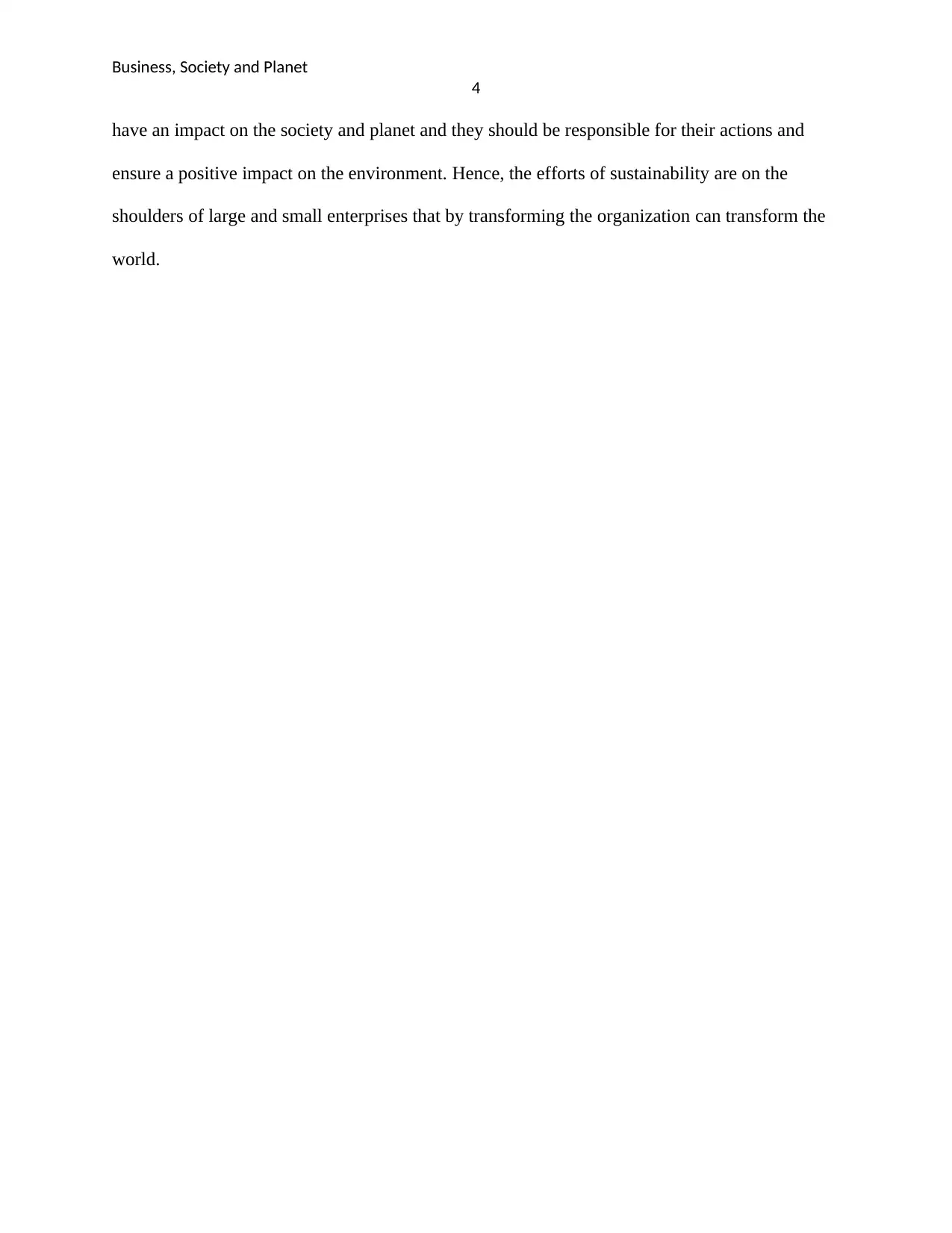
Business, Society and Planet
4
have an impact on the society and planet and they should be responsible for their actions and
ensure a positive impact on the environment. Hence, the efforts of sustainability are on the
shoulders of large and small enterprises that by transforming the organization can transform the
world.
4
have an impact on the society and planet and they should be responsible for their actions and
ensure a positive impact on the environment. Hence, the efforts of sustainability are on the
shoulders of large and small enterprises that by transforming the organization can transform the
world.
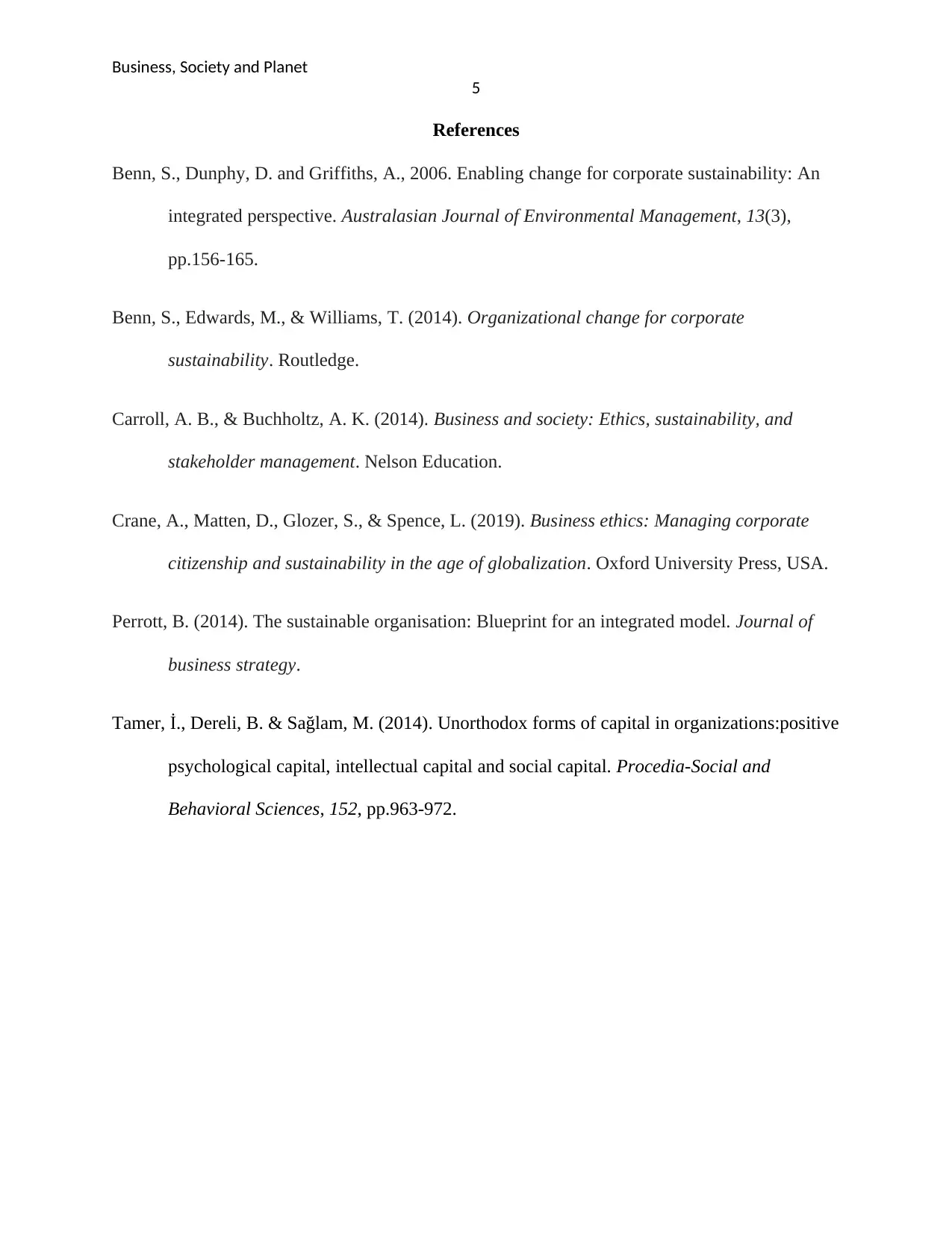
Business, Society and Planet
5
References
Benn, S., Dunphy, D. and Griffiths, A., 2006. Enabling change for corporate sustainability: An
integrated perspective. Australasian Journal of Environmental Management, 13(3),
pp.156-165.
Benn, S., Edwards, M., & Williams, T. (2014). Organizational change for corporate
sustainability. Routledge.
Carroll, A. B., & Buchholtz, A. K. (2014). Business and society: Ethics, sustainability, and
stakeholder management. Nelson Education.
Crane, A., Matten, D., Glozer, S., & Spence, L. (2019). Business ethics: Managing corporate
citizenship and sustainability in the age of globalization. Oxford University Press, USA.
Perrott, B. (2014). The sustainable organisation: Blueprint for an integrated model. Journal of
business strategy.
Tamer, İ., Dereli, B. & Sağlam, M. (2014). Unorthodox forms of capital in organizations:positive
psychological capital, intellectual capital and social capital. Procedia-Social and
Behavioral Sciences, 152, pp.963-972.
5
References
Benn, S., Dunphy, D. and Griffiths, A., 2006. Enabling change for corporate sustainability: An
integrated perspective. Australasian Journal of Environmental Management, 13(3),
pp.156-165.
Benn, S., Edwards, M., & Williams, T. (2014). Organizational change for corporate
sustainability. Routledge.
Carroll, A. B., & Buchholtz, A. K. (2014). Business and society: Ethics, sustainability, and
stakeholder management. Nelson Education.
Crane, A., Matten, D., Glozer, S., & Spence, L. (2019). Business ethics: Managing corporate
citizenship and sustainability in the age of globalization. Oxford University Press, USA.
Perrott, B. (2014). The sustainable organisation: Blueprint for an integrated model. Journal of
business strategy.
Tamer, İ., Dereli, B. & Sağlam, M. (2014). Unorthodox forms of capital in organizations:positive
psychological capital, intellectual capital and social capital. Procedia-Social and
Behavioral Sciences, 152, pp.963-972.
⊘ This is a preview!⊘
Do you want full access?
Subscribe today to unlock all pages.

Trusted by 1+ million students worldwide
1 out of 6
Related Documents
Your All-in-One AI-Powered Toolkit for Academic Success.
+13062052269
info@desklib.com
Available 24*7 on WhatsApp / Email
![[object Object]](/_next/static/media/star-bottom.7253800d.svg)
Unlock your academic potential
Copyright © 2020–2025 A2Z Services. All Rights Reserved. Developed and managed by ZUCOL.





